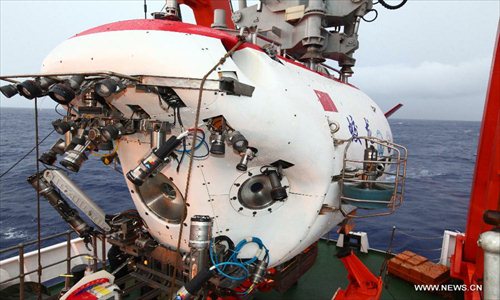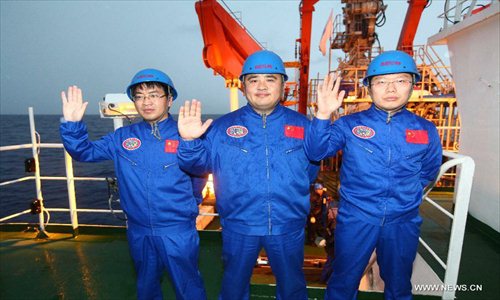China's Jiaolong succeeds in world's first 7,000-meter dive

Chinese oceanauts refreshed the country's dive record in a manned submersible by going deeper than 7,000 meters beneath the sea in a successful test dive Sunday.
The Jiaolong, China's manned submersible named after a mythical sea dragon, reached 7,020 meters below sea level at about 11 a.m. local time (0100 GMT) during its fourth dive into the Mariana Trench in the western Pacific Ocean.
The submersible, which began to dive at 7 a.m. local time (2100 GMT Saturday) in heavy rain, completed its mission at about 6 p.m. local time (0800 GMT) and went back to its mother ship Xiangyanghong 09.
During the 11 hours of diving, the oceanauts worked for almost three hours on the sea floor, collecting water samples and sediments and placing markers at the bottom of the sea.
The three oceanauts, Ye Cong, Liu Kaizhou and Yang Bo, sent greetings from the bottom of the sea to three astronauts who were expected to conduct a manual docking of the Shenzhou-9 spacecraft with the orbiting Tiangong-1 lab module around noon Sunday.
"We wish for a great success of the manual docking and brilliant achievements in China's manned space and manned deep-sea dive causes," said the oceanauts.
Since arriving at the area earlier this month, the Jiaolong had succeeded in reaching depths of 6,671, 6,965 and 6,963 meters in its previous three dives from June 15 to 22, far surpassing the record of 5,188 meters it set last July.
The Jiaolong enabled China to join the ranks of deep-sea faring countries. The United States, Japan, France and Russia currently lead the world in the development of deep-sea exploration technology, each possessing their own submersibles and support bases.
Submersibles of Russia and Japan have reached about 6,000 meters below the sea level.
"It has been proved during the four times of dive that the submersible is stable in function and the capabilities of the team performing the test dives are improving gradually," said on-scene commander Liu Feng, calling all of the team members "heroes."
"The breakthrough of diving deeper than 7,000 meters will enable China to conduct scientific surveys in over 99.8 percent of the world's seabed areas," said Liu Cigui, director of the State Oceanic Administration.
The submersible will attempt two more dives into the Mariana Trench, the deepest place in the world, and is expected to return to China in mid-July with its oceanographic mother ship Xiangyanghong 09.
The six dives will test various functions and performances of the manned submersible at great depths. Each dive may last for eight to 12 hours.
Experts say, for safety, sea dives can only be conducted in daylight under no-more-than-four-class wind and no-more-than-three-class wave.
China initiated the Jiaolong project in 2002. Xiangyanghong 09 left China's eastern coast on June 3 and reached the designated dive zone in the Mariana Trench on June 11.


